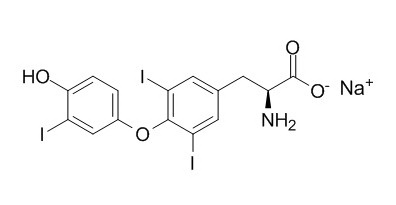3,3'',5-Triiodo-L-thyronine Sodium Salt
The administration of 3,3'',5-Triiodo-L-thyronine Sodium Salt (T3) elicited a vasodilatation in C57BL/6 mice even at the lowest concentration (10(-9)M), a maximal relaxation of more than 50% was observed with the concentrations between 10(-9) and 10(-8)M.
Inquire / Order:
manager@chemfaces.com
Technical Inquiries:
service@chemfaces.com
Tel:
+86-27-84237783
Fax:
+86-27-84254680
Address:
1 Building, No. 83, CheCheng Rd., Wuhan Economic and Technological Development Zone, Wuhan, Hubei 430056, PRC
Providing storage is as stated on the product vial and the vial is kept tightly sealed, the product can be stored for up to
24 months(2-8C).
Wherever possible, you should prepare and use solutions on the same day. However, if you need to make up stock solutions in advance, we recommend that you store the solution as aliquots in tightly sealed vials at -20C. Generally, these will be useable for up to two weeks. Before use, and prior to opening the vial we recommend that you allow your product to equilibrate to room temperature for at least 1 hour.
Need more advice on solubility, usage and handling? Please email to: service@chemfaces.com
The packaging of the product may have turned upside down during transportation, resulting in the natural compounds adhering to the neck or cap of the vial. take the vial out of its packaging and gently shake to let the compounds fall to the bottom of the vial. for liquid products, centrifuge at 200-500 RPM to gather the liquid at the bottom of the vial. try to avoid loss or contamination during handling.
Plant Pathology2022, 10.1111:ppa.13651.
Chemistry of Plant Materials.2016, 33-46
Appl. Sci.2021, 11(24),12080
Plant Commun.2024, 5(10):101005.
Int J Mol Sci.2020, 21(24):9369.
Plant Biotechnology Reports 2021, 15:117-124.
J Adv Res.2021, 35:245-257.
Chulalongkorn University2024, 4761190
Phytomedicine.2018, 40:37-47
J. Pharm. Biomed. Anal.2024, 245:116193.
Related and Featured Products
J Vasc Res. 2014;51(5):350-9.
Vascular function of the mesenteric artery isolated from thyroid hormone receptor-α knockout mice.[Pubmed:
25500991]
This study evaluated the consequences of thyroid hormone receptor-α (TRα) disruption on vascular reactivity.
METHODS AND RESULTS:
The activity of superior mesenteric arteries isolated from TRα knockout mice generated in the SV129 background (TRα(0/0)SV) or in a pure C57BL/6 background (TRα(0/0)C57) was compared to that of their corresponding wild-type strains (SV129 or C57BL/6 mice).
The wild-type SV129 mice exhibited an impaired acetylcholine (Ach)-induced mesenteric artery relaxation compared to C57BL/6 mice, associated with greater responses to angiotensin II (AII) and phenylephrine (PE). The disruption of TRα decreased the vascular response to sodium nitroprusside and PE in both the SV129 and C57BL/6 genetic backgrounds. Responses to Ach and AII were also blunted, but only in TRα(0/0)C57 mice. The administration of 3,3'',5-Triiodo-L-thyronine Sodium Salt (T3) elicited a vasodilatation in C57BL/6 mice even at the lowest concentration (10(-9)M); a maximal relaxation of more than 50% was observed with the concentrations between 10(-9) and 10(-8)M. However, the response to T3 was nearly absent in TRα(0/0)C57 mice.
CONCLUSIONS:
TRα is essential for the control of vascular tone, particularly in thyroid hormone-mediated relaxation. The difference in response to Ach observed between the two wild-type mice should be taken into account for interpreting the vascular responses of genetically engineered mice.



